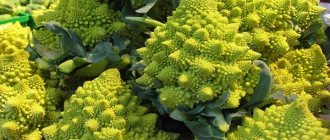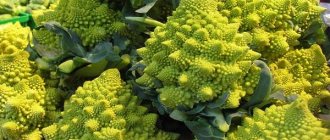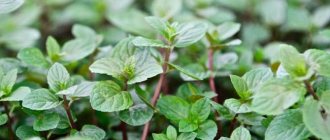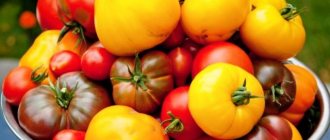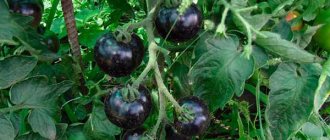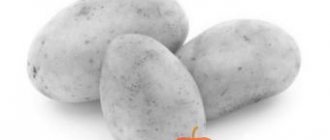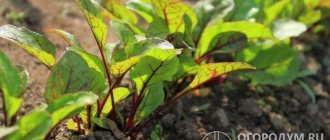Vegetable breeding is developing quite quickly. Nowadays, it is easy to get hybrid potato varieties for your plot. Gardeners prefer to purchase and plant several types of this root crop at once to evaluate each one according to certain parameters. For them, ripening time, good disease resistance and high yield are primarily important. One of the most popular varieties that meets these characteristics is the Gala potato.
History of selection
Gala retains the bright yellow color of the pulp even after heat treatment
The Gala potato variety appeared as a result of the work of German agro breeders and became very popular in Russia. Two years ago it was one of the ten best varieties grown in the Russian Federation. For their early ripening and high resistance to temperature changes and parasites, Gala potatoes are loved by gardeners from regions located mainly in the central and northwestern Federal Districts - Vologda, Pskov, Kaliningrad, Leningrad, Yaroslavl.
What are the differences between potato varieties?
Different varieties of potatoes differ in the appearance of the tubers and the above-ground parts of the plant. Tubers of different varieties have different shapes, colors and tastes. In addition, varieties are characterized by varying resistance to different diseases. And potatoes have a lot of them - about 30 viral, 10 bacterial and more than 50 fungal diseases can affect potato plants. Varieties exhibit their qualities differently in different types of soil. Each variety has its own optimum growth at a certain temperature and humidity. That’s why it’s important to choose the right variety based on your local conditions.
Features of the Gala variety
Root crops of this variety have a presentable appearance:
- smooth surface;
- pleasant yellowish peel color;
- regular oval shape;
- shallow eyes.
Gala is a table potato, so it perfectly retains its taste and appearance in its peeled and processed form: it does not darken or become overcooked. The tubers have light yellow flesh, the color of which is retained even after cooking due to the sufficiently large amount of beneficial carotene. The variety is ideal for dietary nutrition - the percentage of starch content in potatoes is minimal, only 12%.
The ground part consists of strong, almost erect stems of a juicy green color, the leaves are large, slightly wavy, the flowers are white and small.
Advantages and disadvantages
Potatoes of the Gala variety are popular among Russian gardeners:
- This is one of the early varieties, most suitable for growing in the middle zone.
- There are no strict planting dates, there are only recommended ones.
- Gala is easy to care for. The main thing is that there is enough moisture.
- The variety boasts high yields: an average of 20 tubers per bush.
- These potatoes are ideal for a healthy diet due to their low starch content.
- The tubers of the boiled root vegetable will decorate your table - the pulp retains its beautiful color and does not become overcooked at all.
- The pleasant taste of potatoes will surprise even real gourmets.
- Gala is a long-storage variety.
- Resistant to various diseases.
- Grows on any soil.
The disadvantages of the variety include poor resistance to rhizoctonia. This fungal type disease is characterized by damage to the basal stems.
Review of Gala potato variety (video)
Classification and common varieties of potatoes
There are more than 4 thousand different varieties of potatoes in the world; in 2011, the Russian “State Register of Breeding Achievements Approved for Use” included 290 of them. All their diversity is classified according to several criteria.
Varieties are distinguished according to ripening time:
early (50-65 days from planting);
mid-early (from 65 to 80 days);
mid-season (from 80 to 95 days);
medium-late (from 95 to 110 days);
late (110 or more days).
According to their economic purpose they are divided into:
table food , the most common, with high taste, containing less than 18% starch, a lot of protein and vitamin C;
technical , with a starch content of more than 16%; and low amounts of protein, intended for the production of starch and alcohol;
universal , with the amount of starch from 16 to 18%;
fodder , high-yielding, with large tubers, contain a lot of starch and protein.
Table species, in turn, according to their use in cooking, are divided into 4 groups, designated by Latin letters:
- type A - with dense pulp, not overcooked, salad type;
- type B - universal, with dense pulp, slightly mealy, slightly boiled;
- type C – with soft pulp, medium mealiness, highly overcooked;
- type D - completely boiled.
This classification is accepted in Western European countries and is often marked on imported potatoes. Type A is used for salads, types B and C are used for making chips, French fries, mashed potatoes, type D is used only for mashed potatoes.
Another common type of classification is based on the color of the tubers. In Russia, white, yellow and red potatoes are traditionally grown. White potato varieties are considered more tasty and boiled. Red potato tubers store better, they contain more antioxidants and other beneficial substances, and they also form less solanine.
Varieties are also distinguished by the color of the pulp, mostly white or yellow. In our country, preference is usually given to tubers with white flesh, while in Europe yellow potatoes are more popular because they contain more carotene.
Currently, breeding work is underway to create fruits with multi-colored peel and pulp. Red, purple, blue and even black varieties have already been developed and are on sale. They are still quite expensive, but, according to scientists, the brighter the color of the pulp, the more beneficial properties the vegetable has. It is the pigments that provide the unusual color that are responsible for the antioxidant activity of the plant. Multi-colored potatoes appeared on the market in our country recently and in small quantities, although they are already quite well known and popular in Europe and America.
Common zoned varieties
Below are some popular and promising potato varieties released in our country. They are grouped by ripening time and tuber color.
Among the early varieties of red potatoes, the most common are Red Scarlet and Yubilyar with yellow flesh and a starch content of up to 15%, Kholmogorsky, with light yellow flesh, good taste, a starch content of 11 to 14%, Rosara, with a starch amount of 12-16%, excellent taste, relatively resistant to late blight, resistant to nematodes, and cancer.
Among the early varieties of white potatoes recommended for cultivation are Impala and Antonina, with light yellow flesh, high taste, cancer-resistant, with a starch content of 17.7 and 19.4%, respectively; Firm, with creamy pulp, starch 10-12%, all varieties are resistant to cancer and nematodes.
Mid-early varieties of red potatoes, zoned in our country: Visa, with light yellow flesh, Ilyinsky, with white flesh, Guslyar, all boiled, with a starch content of 17-18%, with good taste, resistant to a complex of diseases.
Mid-early varieties of white potatoes:
| Adretta | Odysseus | Nevsky |
high-yielding, with excellent taste, resistant to late blight of tubers, cancer, drought-resistant; all types with light yellow flesh.
Mid-season varieties of red potatoes:
| Peter's mystery | Rocco | Aurora |
with creamy pulp, resistant to cancer and nematode; with a starch content of about 12%, 14%, 17%, respectively.
Mid-season varieties of white potatoes:
| Ket | Pirol | Kolobok |
with yellow pulp, starch up to 17%. , with an amount of starch of 11-13%.
Mid-late and late varieties of red potatoes:
| Zhuravinka | Zdabytak | Asterix |
with pale yellow flesh, starch up to 19%, resistant to cancer and nematode; to late blight; have a long period of rest.
Mid-late and late varieties of white potatoes:
| Saturn | Gull | Atlant |
with light yellow pulp, good taste, starch content of about 21, 15, 22%, respectively.
Popular Dutch varieties
In the market of our country, varieties of Dutch selection are popular, which are distinguished by the correct shape of the tubers, small eyes, and, subject to the correct cultivation technology, ensure high yields. The advantage of Dutch selection seed potatoes is the absence of diseases, since the planting material undergoes thorough pre-sale testing. It is usually resistant to various viruses, nematodes and, to a large extent, scab. The disadvantages include the high degree of damage to the tops by late blight, which requires repeated treatments of the plantings, however, the tubers are usually resistant to the disease and are stored well.
Among the Dutch varieties, early and mid-season varieties predominate; late varieties are quite rare. Some of them are used so widely that they are included in the State Register of the Russian Federation. These are early Sante, Romano, Condor; late Agria, high-yielding, with good taste. Also on sale are early-ripening seed potatoes Prior, resistant to nematodes and late blight of tubers, ultra-early Ariel, which produces a harvest before late blight appears; with good keeping quality; mid-late Eba, resistant to viral diseases, adapted for growing on sandy soils; highly productive Cleopatra, early, with red skin and light yellow pulp, large tubers, with a yield of up to 2.5 kg per bush. A new promising variety, Estima, is becoming increasingly widespread; it is mid-early, high-yielding, and not affected by viral diseases.
Some exotic varieties
Tubers with multi-colored pulp are still unusual for our consumers, but they are already quite common abroad. They are grown in the northern regions of Canada, the USA, and Scandinavia, since, according to observations, such potatoes are more resistant to unfavorable conditions. It is usually early and ultra-early, with a ripening period of 70 - 100 days.
As an example, we can cite tubers grown in Alaska with skin and pulp the color of ripe cranberries, Huckleberry and Cranberry Red, which ripen in 60 to 70 days, suitable for frying and salads, where they completely retain their original color.
Another early species, All Blue , has a spectacular blue color, ripens in 80-90 days, is productive, and has good taste.
The Peruvian variety with purple skin and pulp, Purple Peruvian, produces large tubers that are purple, almost black, inside and out; it is productive, but places high demands on soil fertility and moisture.
It should be especially noted that thanks to the achievements of modern science, edible tubers of any color except green have been created. Green potatoes are not suitable for food, because their color indicates the accumulation of the poisonous alkaloid solanine in the plant.
udec.ru
Landing Features
In order for potatoes to please you with an excellent harvest, you need to plant the plant correctly.
Seed material
The mistake of many novice gardeners is their belief that smaller potatoes will do for planting. This is a deep misconception. Future seed material is prepared by digging up the crop or purchased at the market or selection fairs.
Important! Gala potato tubers for planting should be medium in size and weigh about 80 grams.
Such root crops have enough eyes for a future good harvest. The smaller the tuber, the sparser the bush will be. Too large specimens are also not recommended - there is a risk of rotting. In planting, as elsewhere, you need a “golden mean”.
Sprouted potatoes will sprout faster
Many experienced plant growers germinate potatoes for quick germination in the future. For this purpose, the tubers are laid out in a box in 2-3 rows, each layer is sprinkled with sawdust and watered.
Important! A few days before planting, it is necessary to warm the potatoes in the sun. The tubers must be laid out on a flat, dry surface.
Selecting a location
Potatoes of the Gala variety prefer loamy soils. It is necessary to maintain low or normal soil acidity (4.5–5.5 pH) - do not overuse organic fertilizers.
Important! Soil acidity can be reduced using ordinary wood ash at the rate of 200–300 g per square meter.
It is recommended to prepare the land for future planting of potatoes in the fall. Fertilizers are applied for digging:
- ammonium nitrate (13 g per sq. m) or urea (10 g per sq. m);
- 30% potassium salt (12 g per sq. m);
- double superphosphate (15 g per sq. m.).
Photos and descriptions of high-yielding potato varieties
| [td] Yield potato varieties |
Rosalind
The new German variety has justified ambitions for expansion into the fields of potato growers in Russian regions. It has erect plants, red-violet flowers, oval large pink tubers with creamy flesh. It produces a lot of tubers, up to 15 pieces, and they all reach a weight of at least 100 g by the end of August. Rosalind relies on good agricultural technology and loves watering and fertilizers. Getting a yield of 500 kg per hundred square meters with this variety is not a problem
Bellarosa
A super early, promising variety of German selection, which has just been tested in Russia. The new product is an order of magnitude superior to previously cultivated varieties in terms of disease resistance, starch content, and taste. Thus, very early tuberization (the second ten days of July) helps to avoid late blight damage to both tops and tubers. This variety practically does not require the use of pesticides. The tubers of this variety differ even from others. They are red, large, with very small, superficial eyes, and very, very beautiful. Well, the taste is simply great! "Bellarose" should be on every potato plot.
Vineta
The tuber is oval-round. The peel is yellow. The pulp is light yellow. The weight of the commercial tuber is 67-95 g. The starch content is 12.9-15.2%, the taste is good and excellent. Marketability 87-97%, at the standard level. Keeping quality 87%. Resistant to the pathogen of potato cancer and to the golden potato cyst nematode. Susceptible to the causative agent of late blight on tops, moderately susceptible on tubers. According to the originator, it is resistant to wrinkled and striped mosaic viruses, leaf curl, and tolerates drought well. Value of the variety: nematode resistance, drought resistance, friendly early production, high taste of tubers.
RED FANTASY
A mid-early variety that will not leave any potato grower indifferent. Its highly commercial tubers are beautiful, mostly medium and large in size, elongated oval in shape, with red smooth skin and superficial eyes. The pulp is yellow, has high consumer qualities: tasty, does not darken when cooked. The new variety has high plasticity and is moderately demanding of soil and moisture. The variety is resistant to nematodes and potato cancer, the main dangerous fungal diseases - common scab and late blight of leaves and tubers.
Colette
The tuber is elongated-oval. The peel is yellow. The pulp is light yellow. The weight of the marketable tuber is 66-125 g. The starch content is 12.2-15.2%, 1.5-2.7% lower than the standards of Volzhanin, Bryansk early. The taste is good. Marketability 76-98%, at the standard level. Keeping quality 92%. According to the originator, it is recommended to germinate the tubers before planting. Resistant to potato cancer pathogen and golden potato cyst nematode. According to the All-Russian Research Institute of Phytopathology, it is susceptible to the causative agent of late blight on tops and tubers to isolates isolated in the Moscow and Sakhalin regions. Value of the variety: nematode resistance, early production, evenness of tubers, suitability for processing, good keeping quality of tubers.
LILAC (SUPER NEW!!!!)
For the first time in Russian selection, tubers with PURPLE PULP (for salads, vinaigrettes, etc.) High content of antioxidants! Type of dietary food. Very limited propagation, hence the high price - 1 tuber - 120 rubles.
"ZHUKOVSKY EARLY"
Early ripening: 70-80 days. A flexible variety that produces high yields in various soil and climatic conditions. When planted in the soil, the tubers actively germinate even at low temperatures. Tubers of pink color, leveled, are stored for a long time. One of the best varieties in terms of taste. Drought resistant. Resistant to scab, potato nematode and rhizoctonia.
"WHITE SPRING"
Early ripening: 70-80 days. Table variety with high marketability. The tubers are white, oval, for household needs appear in 55-60 days (become shelf-stable in 70-80 days), good taste. The weight of the commercial tuber is 100-185 g. It is stored well, but is mainly used as fresh early potatoes. Moderately resistant to rhizoctonia and common scab, susceptible to late blight.
"TIMO HANKKIJAN"
Early ripening: 70-80 days. Variety from Finland, table variety, productive, suitable for growing on all types of soil. The tubers are white, round, good taste, and can be stored for a long time. The weight of a marketable tuber is 65-120 g. The shoots are friendly and powerful. The variety is resistant to elevated temperatures, drought and waterlogging. Resistant to rhizoctonia, blackleg, scab, moderately resistant to late blight.
"LUCK"
Early ripening: 70-80 days. A popular high-yielding table variety, suitable for both summer and winter consumption. The tubers are oval, white, with high taste. The weight of a marketable tuber is 90-120 g. The shoots are friendly and powerful: a marketable harvest can be obtained already in June when planted with germinated tubers. The variety is resistant to late blight and blackleg, and is moderately resistant to damage by the Colorado potato beetle.
"SANTE"
Mid-early: 80-90 days. High-yielding Dutch variety of universal use. The tubers are large, oval in shape with yellow skin and light yellow flesh, good taste. It has good marketability and preservation. Suitable for processing into French fries. Resistant to potato nematode, late blight, viruses, moderately resistant to common scab, susceptible to rhizoctonia.
"CONDOR"
Mid-early: 80-90 days. A high-yielding Dutch table variety with high marketability. The tubers are large, elongated oval in shape, with red skin and light yellow flesh. They store well and have excellent taste. The weight of the marketable tuber is 90-180 g. The variety is resistant to viral diseases and common scab, and is susceptible to late blight.
"ROMANO"
Mid-early: 80-90 days. A Dutch table variety with high marketability, enjoying growing popularity. The tubers are round-oval and regular in shape, the skin is pink, strong, not damaged during harvesting, the flesh is light cream, the taste is good. The weight of a marketable tuber is 70-80 g.
"NEVSKY"
Mid-early: 80-90 days. A high-yielding table variety with high marketability and excellent taste. The tubers are round-oval in shape, the skin and pulp are white. The weight of the marketable tuber is 90-130 g. The preservation of the tubers is good. The variety is resistant to rhizoctonia, moderately resistant to late blight, and common scab. Resistant to drought and waterlogging
"FAIRY TALE"
Mid-early: 80-90 days. High-yielding variety with good marketability. The tubers are oval, the peel is yellow, the flesh is white, the preservation is good. The weight of a marketable tuber is 76-129 g. The variety is distinguished by its multi-tuberism: it can produce up to 30 or more potatoes per bush. Resistant to late blight, susceptible to nematodes.
"LUGOVSKOY"
Mid-season: 90-110 days. A high-yielding table variety with high marketability and good taste of the tubers. The tubers are oval in shape, the skin is light pink, the flesh is white, the preservation is good. Weight of marketable tuber is 85-125 g. The variety is resistant to late blight, common scab, moderately resistant to blackleg.
"AGRIA"
Care
Potatoes of the Gala variety do not need special care during the growth and formation of tubers, but they will be grateful for the provision of sufficient moisture - it is necessary to avoid drying out and cracking the soil around the bush.
Top dressing
Before performing root feeding, it is necessary to loosen the soil. The plant is fertilized:
- chicken manure (dilute with water in a ratio of 1:10). You need to water the grooves between the rows of plants with this solution;
- urea (1 tablespoon per ten liters of water). The norm is 0.5 liters per bush;
- ammonium nitrate at the rate of 20 g per 10 liters of water.
After all the manipulations, you must water the soil around the bush and between the rows.
If during the growing season thin stems and small yellowish leaves are observed, the bush is stunted in growth, it is necessary to fertilize the plant in three stages:
- Before the flowering period - with urea (dilute a dessert spoon of the product in 10 liters of water).
- The period of bud formation - with ash and potassium sulfate (for 10 liters of water you need to take 1 glass of ordinary ash and a full tablespoon of potassium sulfate).
- During flowering - superphosphate (1 tablespoon per 10 liters of water).
You should water 0.5 liters strictly for each bush.
In addition, you can carry out the feeding procedure using dry fertilizers - scatter half a teaspoon of urea under each bush.
Mineral nutrition of potatoes (video)
Protection from diseases
Gala is highly resistant to the following diseases:
- common scab;
- potato nematode R01, R04;
- potato cancer;
- virs Y;
- blackleg;
- glandular spotting;
- late blight
- virus that causes leaf curl;
- late blight of tops;
- rhizoctonia.
Rules for storing potato harvest Granola
After harvesting, dry the potatoes and treat all tubers with a solution of copper sulfate (ratio of 2 grams per 10 liters of water).
Selected seed potatoes are placed in one pile, and those intended for consumption in another.
For long-term storage, prepare a cool, ventilated, dry room. Recommended storage temperature is from +2 to +5°C. Periodically, you should look through the harvest and select rotten fruits so that the rest of the potatoes do not rot.
The shelf life of this variety is 97%.
Harvesting
Ripening time
Tubers of the Gala variety ripen 70–80 days after the appearance of the first shoots. The yield is on average from 20 to 25 root crops per bush weighing about 120 g. They have an oval shape and a smooth white skin. Potatoes are very resistant to mechanical damage.
The Gala variety has a regular round-oval shape
Storage duration
If you destroy the tops one and a half to two weeks before digging up the potatoes, you can achieve full ripening and increase the shelf life, which is already long for the Gala variety.
Important! Before collecting tubers in containers for winter storage, they must be thoroughly dried to avoid rotting.
Potatoes of the Gala variety have a long shelf life
We study potato varieties in the photo and by description
When studying potato varieties in photos and descriptions, you may encounter a number of questions. For example, what is better - the prolific Dutch or our unpretentious one?
Which potato variety to choose
When choosing potatoes, you may find that Dutch ones are considered the best. In general, foreign varieties grown on the basis of hormones and suspicious fertilizers, prohibited as carriers of GMOs, have many advantages. But domestic varieties are still considered competitive. Which varieties are the most popular?
- Zhukovsky early - its ripening time is 70-80 days. This variety is loved for its plasticity. It also has good yields. Even low temperatures won't bother him. It also has some of the best taste;
- Spring white is also an early ripening plant. This variety is a table variety and has high marketability. Potatoes have beautiful white tubers. The variety is considered tasty;
- Timo Hankkiyan has a good marketable mass of tuber. This variety was imported from Finland. All types of soil are suitable for cultivation. The tubers are round in shape, white, with good taste. Its shoots are friendly and strong. The variety is suitable when it is to be grown in drought;
- Udacha is another early ripening variety. He is very popular. You can get a large number of fruits. The first commercial harvest is obtained in June;
- Povin is an early variety of Ukrainian selection. A very popular variety. The peel is red, the tubers are round, medium in size;
- Borodyansky pink is a mid-early variety of Ukrainian selection. The peel is pink, the tubers are round, medium size;
- Dnepryanka is an early variety of Ukrainian selection. The peel is yellow, the tubers are round and large;
- Lugovskoy is a mid-season variety of Ukrainian selection. The peel is pink, the tubers are oval, large;
- Tiras is an early variety of Ukrainian selection. The peel is pink, the eye stands out bright red, the tubers are oval, large;
- Slavyanka is a mid-season variety of Ukrainian selection. The peel is red, the tubers are round and large;
- Fantasia is a mid-season variety of Ukrainian selection. The peel is pink, the tubers are oval, large;
- Shchedryk is a mid-early variety of Ukrainian selection. The peel is yellow, the eye stands out bright red, the tubers are oval and large.
Brief tips on agricultural technology
When selecting a potato variety for planting, it is necessary to study the various growing conditions and soil characteristics in Ukraine. Based on this, it will be easier to choose the variety you are interested in. Pay attention to studying agricultural cultivation techniques, become familiar with moisture conservation techniques such as loosening and mulching potatoes, look at planting patterns and drip irrigation.
In addition, it is advisable to take note of compliance with crop rotation requirements, otherwise the soil will be depleted and diseases and pests that are dangerous for nightshades will accumulate in it. Green manure will help restore the soil.
Characteristics
Let’s touch a little on the characteristics of potatoes based on their ripening time. Potatoes of early varieties, although they produce less yield, due to their early ripening, provide early vitamins and nutrition. Often, gardeners choose early potato varieties because they tolerate dry times well and have time to gain weight. Proper collection and timely removal of tops will protect potato tubers from late blight. Many of them are well kept.
Mid-season varieties are more often susceptible to fungal diseases, and therefore require more care (regular spraying, pruning of affected tops). But you can select such high-yielding varieties that you will provide yourself and all your relatives with wonderful potatoes until the beginning of summer.
Late varieties are also demanding of care; usually these potatoes are harvested before the end of September. They are not recommended to be planted in the south, since the plants suffer greatly from drought and when the heat sets in, they try to withstand a dormant period without growing tubers. Depending on the variety, the yield is high; tubers are subject to long-term storage.
Flesh colors
Naturally, if you are deciding for the first time which variety of potatoes to choose for planting, you need to look at a lot of photos and read the descriptions. Perhaps you will choose a variety with colored pulp that is new to our latitudes. In the West and the American continent, they love varieties with pulp of cranberry, beet, blue, purple, and so on.
Our consciousness is still familiar with the creamy, yellow and occasionally pinkish colors of the pulp. Perhaps this is temporary. After all, the colored pulp contains many useful substances.
We looked at several varieties. There are many more of them. Famous Dutch Condor, Picasso, Courage, Romano, Carrera and Sante, which taste good and last a long time. Dutch early Ariel, Riviera, Prior, Red Scarlett, Estima manage to produce a magnificent harvest before being affected by late blight. Remember that an accurate conclusion can only be drawn from experience, multiplied by the desire to get results. You can only understand which varieties of potatoes in the photo are better through practice.
OgorodSadovod.com
Reviews
Just this summer I planted 2 kg of this variety, bought at OBI. In general, I like varieties with yellow flesh and not overcooked. This variety pleased me. Otherwise (in terms of cultivation, early maturity), it was no different from the other two planted (“Red Scarlet” and “Nevskaya”). But the taste is quite to my liking.
Vera Shelest
https://otvet.mail.ru/question/172695149
The bushes of this variety are not spreading, but grow upward, so it does not take up much space in the garden, it clumps together and stretches upward. We have heard a lot about how this variety is resistant to all sorts of diseases; we personally have not encountered any, and that’s good. Another advantage of this variety is that it ripens quickly, about two and a half months. In appearance, the potato is ideal for transportation and storage; it is oval in shape with a thin skin, there are almost no eyes and they are tiny. Very convenient to clean and wash. The color of the potatoes is yellow, I personally love yellow, it gives a very beautiful color when cooked, the consistency is also pleasing, it doesn’t get soggy!
Runa
https://otzyv.pro/reviews/otzyvy-kartofel-gala-32688.html
Gala is superior in its characteristics to many other popular potato varieties. Thanks to its early ripening and ease of care, this breeding species has become a favorite for many beginners and experienced gardeners.
At the moment, you can count a huge variety of potato varieties of different breeding and different countries of production. German potato varieties occupy their established niche, loved by gardeners and farms, due to the fact that most varieties are resistant to diseases, produce high yields, have good taste and German quality.
Planting and growing Vitara
1-2 weeks before planting, you should remove the seed from storage, during which time it should warm up and begin to produce small sprouts. After the first shoots appear, sowing can begin.
Important! Clay-containing soil is extremely unsuitable for planting this crop. Since water stagnates in the soil and contributes to rotting of the root crop.
Planting potatoes Vitara
Due to their unpretentiousness in care and planting, potatoes do not require special preparation. Vitara is an early ripening variety and therefore planting can be carried out even at the end of May. The tubers should not be deeply buried; 8-10 cm is enough.
It is necessary to carefully monitor the appearance of weeds and periodically loosen them to enrich the fruits with additional oxygen. A walk-behind tractor is suitable for hilling root crops; this variety is not afraid of mechanical stress. This procedure should be performed twice.
Hilling up should be done within 4-5 weeks after planting. The crop does not require special care, only standard weeding, watering and hilling.
For reference! Watering is done on average once every 20-25 days.
Harvest storage
Features of German selection
The Russian word “potato” comes from the German “Kartoffel”. German varieties of this vegetable crop have long been in demand not only by gardeners for growing in their own plots, but also by large vegetable farms.
Most potato varieties of German selection stand out due to their sufficient resistance to diseases, the formation of a high yield, as well as the very good taste of the tubers. Currently, the characteristics of almost any variety and its detailed description are publicly available, so the gardener can only choose the most suitable variety for himself and read the reviews of other potato growers.
Rules for storing Vitara potato harvest
Root vegetables should be stored in a ventilated and dry place, placed in bags or nets that allow air to pass through well.
The presence of slight humidity is quite acceptable. The storage temperature should not exceed +4-5°C degrees, otherwise the fruits will begin to germinate and dry out ahead of time.
The keeping quality of the variety is 95%.
The productive Granola potato variety from Germany and its characteristics, as well as the description of the Vitara potato variety, indicate that it is quite acceptable to grow them in Russia. In terms of productivity and taste, they are not inferior to other varieties, in some aspects they even surpass them. These varieties are edited annually through selection, which means the crop will only get better over time.
The best varieties
In recent years, varieties bred by the private German enterprise Saatzucht Fritz Lange KG have become especially popular among gardeners. This company has been engaged in breeding and seed production for almost a century, and also sells seed planting material.
In 2015, the State Register of Russia included only seven potato varieties that were approved for cultivation in our country.
Planting and Growing Granola
Before planting, the planting material should be prepared. Tubers for planting are selected in the autumn from the best bushes, during the harvesting of the grown crop. Tubers must be whole and healthy.
Important! You should select fairly large fruits; you do not need to choose small seed potatoes, because this approach is not permissible for this variety, and neglect can harm the yield and impair fruitfulness.
Seed potatoes should be thoroughly dried and placed in boxes with good ventilation for storage; they should not be covered to prevent rot and mold from forming.
Drying potatoes
In spring, the tubers will begin to be covered with small sprouts, but to obtain seedlings they should be broken off.
Reviews from gardeners
Currently, judging by reviews, gardeners are especially in demand for such varieties from German selection as “Adretta”, which has long been considered the standard of quality and taste, as well as the mid-season and highly marketable “Agave”. “Karatop” is very popular for obtaining very early vegetable products, which allows you to get two harvests per season.
The early-ripening, table-purpose, with o and drought-resistant and high-yielding variety “Vitara”, bred on the basis of the Adretta potato, have also proven themselves well. In the opinion of most gardeners, the leading position in terms of ripening speed, taste, yield volume and storage duration is occupied by the “Rosara” variety.
Mid- and late-ripening varieties
There are mid-early varieties with a growing season of up to 100 days and mid-season varieties with a growing season of up to 125 days. Tuber formation in these varieties occurs 80–100 days after germination.
Late potato varieties vegetate for 140 days or more. Tubers are formed 110 days after planting.
These varieties have powerful tops and consume large amounts of moisture.
Mid-ripening and late-ripening varieties are characterized by greater accumulation of starch and dry matter, excellent taste and good keeping quality. However, you need to understand that late blight, the scourge of potatoes, can cause significant damage to the harvest of these varieties. Compared to early varieties, late potato varieties are, as a rule, more resistant to this disease, but still, already from mid-July, a background favorable for late blight develops in many regions - rains, cold dew and hot weather during the day. By this period, the early varieties had mostly already given up their harvest, and the later varieties may require chemical protection.
Mid-season varieties:
- Varieties of Russian selection - Lazar, Yugra, Resurs, Vasily.
- Varieties of Belarusian selection - Skarb, Krinitsa, Zhivitsa, Garant.
- Varieties of Dutch and German selection - Rosalind, Romano, Roko, Ramos.
Late-ripening potato varieties:
- Varieties of Belarusian selection - Zdabytak, Alpinist, Zarnitsa, Suzorie, Vesnyanka.
- Varieties of Dutch and German selection - Rodeo, Mondial, Asterix.
- Varieties of Russian selection - Vityaz, Malinovka, Lorch.
- The variety of Ukrainian selection is Teterev.
Varieties for different geographical locations
You may be interested in: Dates for planting potatoes in 2022 for central Russia and the Moscow region Dates for planting potatoes in May-June 2022 according to the lunar planting calendar Favorable days for planting potatoes in 2022 according to the lunar calendar
The correct climate, temperature, and humidity levels determine the possibility of obtaining maximum yield. Thanks to many years of selection and optimization, the most adapted varieties for the conditions of a particular region of Russia were obtained:
- potatoes for the Moscow region - Nevsky, Lugovskoy, Vesna, Timo, Zhukovsky;
- middle zone - Sosnovsky, Skarb, Slavyanka, Belorussky, Vineta, Druzhny, Vyatka, Velikan, Udacha, Ural early, Bellarosa;
- north - Gloria, Bronnitsky, Krepysh, Visa, Ladozhsky, Ermak, Garnet;
- northwest - Adretta, Aurora, Impala, Zhukovsky early, Amorosa, Romano, Latona;
- south - Red Scarlett, Arizona, Goryanka, Golubizna, Evgeniya, Hermes.
Important!
There are special potato varieties for the Urals and Siberia - Baron, Rosara, Antonina, Snegir, Governor, Tomich, Priobsky, which feel great in cool and short summer conditions.
Every year, new potato varieties appear with increased resistance to the Colorado potato beetle, nematodes, diseases, and adverse weather conditions. Recent breeding trends place special emphasis on the aesthetic component. Most of the new products (Gurmand, Blue Salad, Miami, Fidelia, Ruby) have an original purple or burgundy color, the shades of which are preserved in the pulp.
Red Scarlet Potatoes
These are early, very productive potatoes and belong to the Dutch varieties. It surpasses many well-known varieties in terms of productivity. The bush is about 70 cm high, forms 7-8 stems, the flowers are red-violet. The tubers are elongated-oval with a smooth red skin, yellow flesh and small eyes. There are usually 20 or more tubers in a nest, each weighing 80-85 g. The Scarlet potato variety is resistant to late blight, cancer, and leaf curl. It tolerates drought well, making it suitable for growing in very hot climates. The ripening period is about 75 days. When cooked, potatoes of this variety do not fall apart, maintaining the appearance of tubers. It does not darken during cutting, which is typical for many other varieties. Tubers store well in winter. The Scarlet variety is resistant to the most well-known viral diseases, but weakly resistant to common scab. The variety is sensitive to late blight of tops, but at the same time resistant to late blight of tubers, which is more important.

